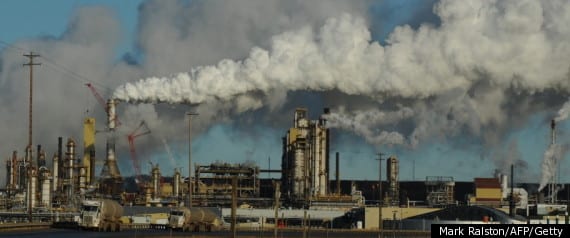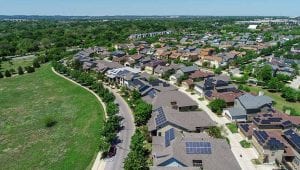The Canadian province of Alberta, home to the third-largest proven crude oil reserve in the world, has unveiled a sweeping new climate policy that will impose a hard cap on greenhouse gas emissions from its oil-sands and phase out coal-fired power generation by 2030.
The plan, which the Canadian Press reports is the result of months of study and public input, will introduce a broad-based carbon tax that will apply across the economy and will help Alberta shift to 30 per cent renewables, also by 2030.

“This is the day we step up, at long last, to one of the world’s biggest problems — the pollution that is causing climate change,” said Alberta Premier Rachel Notley at the launch of the policy in Edmonton on Sunday.
Joining her at that launch were, leaders of major energy companies, environmental groups and First Nations – groups, the CP noted, that have in the past been at each other’s throats over the issue.
“I’m hopeful these policies will lead to a new collaborative conversation about Canada’s energy infrastructure on its merits and to a significant de-escalation of conflict worldwide about the Alberta oilsands,” Notley said.
These are the same oilsands, of course, that were to have supplied the 850,000 barrel per day Keystone XL pipeline from Alberta to Texas – a highly controversial project that US President Barack Obama scuppered, when he announced earlier this month that it “would not serve the national interest of the United States.”

And considering the weekend’s announcement, that might be just as well. The new policies will see the oilsands limited to a total of 100 megatonnes of emissions — about 30 megatonnes more than the industry now emits; a gap CP says will be largely filled by projects now being built.
“That means if oilsands producers want to pump more oil, they’ll have to do it in a way that stays under the cap,” Canadian Press reports.
The details of the policy so far are that, starting in 2017, Alberta will apply a $US20-a-tonne price on carbon emissions that will cover about 90 per cent of the economy, including petrol and home heating fuel. That price will increase to $30 the following year.
That $30 will add about seven cents to the cost of a litre of petrol. The total cost of the increases will be about $500 a year for an average family, according to government calculations.
The money raised — about $US3 billion in 2018 — will then be used in part to rebate middle and lower income families. About 60 per cent of households will have at least some part of their carbon tax bill repaid.
The rest will go to programs to ease the transition away from coal, boost the switch to renewables, and fund innovation programs and energy efficiency measures.
Eventually, said Notley, the carbon taxes could be dedicated toward paying down public debt.
Large emitters will continue to be regulated based on their carbon emissions per barrel of oil, although those requirements will be more stringent.
CP reports that a mediator will be appointed to work out the details of coal plant closures with power companies, who, not surprisingly, were not part of the happy cohort on stage at the announcement.
Outside of Canada’s coal industry circles, the plan has been applauded. Mark Jaccard, an energy economist at Simon Fraser University, called it “a prudent mix of sound economics and real-world pragmatism that creates incentives for emissions reductions.”
But a Google News search quickly reveals a number of opposing views, not unlike those aired in Australia when the Gillard government’s now-defunct “carbon tax” was first implemented.
“This new carbon tax will make almost every single Alberta family poorer, while accelerated plans to shut down coal plants will lead to higher power prices and further jobs losses,” said Brian Jean, the leader of Alberta’s opposition Wildrose Party.
And “now that Alberta’s new NDP government has decided to phase out coal for power generation, while at the same time promising that power supplies will remain reliable and affordable, can we expect government trucks to start driving the streets drafting students, out-of-work oilfield workers and small business owners to go to the forests and chop firewood?” asks an op-ed in the Toronto Sun.
“‘Cause that’s about the only way Premier Rachel Notley’s “green” dream will ever work. We’ll need to heat our homes with wood-burning stores. And maybe some dried cowpies, too.”
It’s interesting to note, though, that the province’s oil majors are, so far, seemingly on board with the policy, perhaps because it is aimed more squarely at the coal industry.
Tim McMillan, president of the Canadian Association of Petroleum Producers, said the policy contained opportunities for the industry, with natural gas identified as a potential “backfill” as coal power is phased out.
Brian Ferguson, the CEO of oil sands producer Cenovus Energy was even more positive in his review of the policy.
“It enables Alberta to be a leader, not only in climate policy, but also in technology, innovation, collaborative solutions and energy development,” he said.
“I believe it will lead to Albertans and Canadians receiving full value for their oil and natural gas resources, while addressing climate change.”
And Steve Williams, chief executive of Canada’s largest oil company, Suncor, described the policy as “a sensible, reasonable balance.”
“It’s literally a game-changer,” Williams said, “it will create a wealth of opportunities and jobs for future generations.”
Out of interest, below is a graphic from Canada’s CBC Calgary on the carbon profile of Alberta’s oilsands.

According to another op-ed, this time in the Calgary Herald, Alberta has not disguised “its intent to use the report to enhance its reputation at the Paris climate conference and said ‘the time to show your leadership and talk to your market is when people are listening’.”










